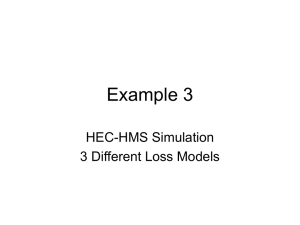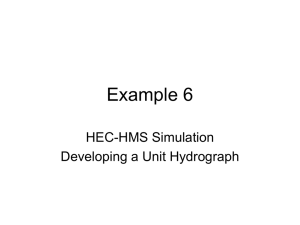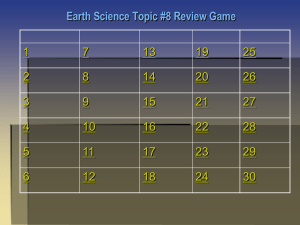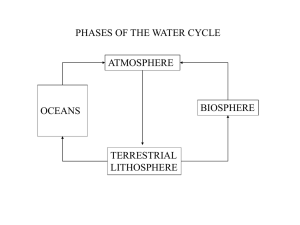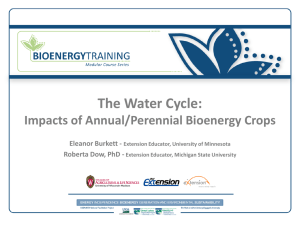Lesson-6
advertisement
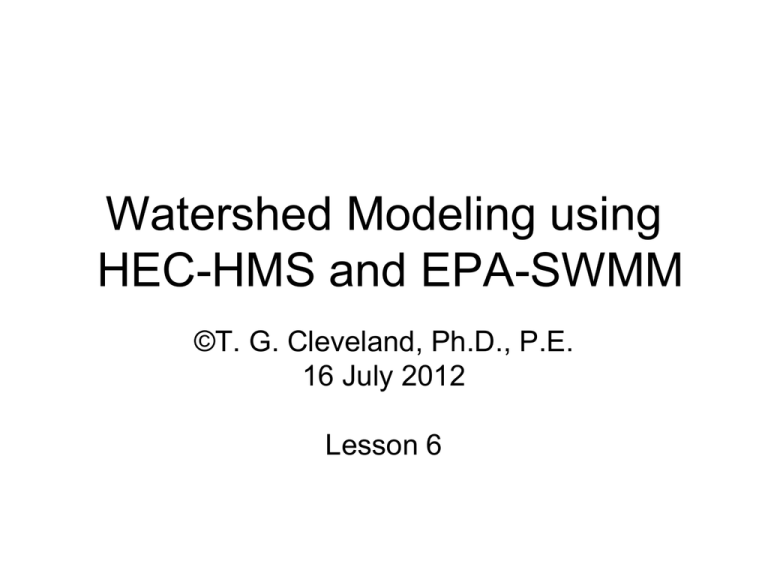
Watershed Modeling using HEC-HMS and EPA-SWMM ©T. G. Cleveland, Ph.D., P.E. 16 July 2012 Lesson 6 Runoff Generation • Rainfall-Runoff – Excess precipitation, it is what’s left after abstractions (losses) are satisfied • HEC-HMS Runoff Generation – Infiltration, canopy, depression storage. – Evaporation elsewhere (met model) • SWMM Runoff Generation – Infiltration, depression storage. – Evaporation elsewhere (raingage model) Rainfall-Runoff Process • Precipitation – Meterology, Climate • Watershed • Runoff – Fraction of precipitation signal remaining after losses – – – – Losses Transformation Storage Routing HEC-HMS • Hydrologic Cycle Components in HECHMS (circa 2008) Rainfall, P(t) Snowfall Evapotranspiration Snowpack Snowmelt Infiltration Loss Land Surface and Vegetation Runoff Percolation Loss Channels Runoff Reservoirs Discharge, Q(t) Rainfall-Runoff • Precipitation (rainfall) is the raw input – Distributed in space and time – Commonly assumed uniform in space for hydrologic computations (refine later) • A component of this signal never appears as runoff, it is “lost” • Excess precipitation (rainfall) is the component of the signal remaining after losses. Rainfall-Runoff • As a process diagram: Precipitation Losses Loss Model Excess Precipitation Loss Models • Vital to achieve volume balances • Cannot easily measure – Biggest source of uncertainty in hydrologic modeling • Used in calibration where data are available – Loss models get used to “tune” a model Infiltration • Infiltration is water that soaks into the ground. This water is considered removed from the runoff process. • Largest contribution to losses during a storm event, hence most loss models are some form of an infiltration accounting Loss Models • HEC-HMS/SWMM – Losses are infiltration losses. – Evaporation is modeled as a component of meterology (HMS) or raingage (SWMM) • Infiltration accounting defined by soil properties and ground cover. – Soil type (sand, clay, silt, etc.) – Land use (percent impervious, etc.) Hortonian Infiltration • Empirical, localized – Rate has an initial and asymptotic value. – Integral of rate is total depth (volume) lost Loss Models • HMS/SWMM Common Models – Green-Ampt – NRCS Curve Number • HMS specific – Initial Abstraction, Constant Loss – Exponential Model – Phi-Index (and proportional rainfall) – Soil Moisture Accounting – Deficit/Constant Loss Model: Green-Ampt • Infiltration model based on constant head or constant vertical flux into a porous medium. – Assumes soil behaves like a permeameter. – Uses Darcy’s law (adjusted for soil suction). • Four parameters: – Initial and saturated water content – Soil suction and saturated hydraulic conductivity Loss Model: Green-Ampt Flux (infiltration rate); Governed by saturated hydraulic conductivity, soil suction, and accumulated infiltration. Volume infiltrated over time; Governed by flux, change in water content. Loss Model: Green-Ampt • Parameter estimation – Initial water content • wilting point is a good lower bound for modeling – Saturated water content • porosity is a good approximation – Saturated hydraulic conductivity • Infiltrometer measurements – Soil suction • Textural description • Hanging column measurements • Local guidance – (e.g. Harris County has suggested GA parameter values) Loss Model: Green-Ampt • Advantages – Documented soil saturation theory – Parameters can be estimated either by measurement or textural soils description • Disadvantages – Parameter estimates NON-TRIVIAL. – More complex than rest of hydrologic model. • HEC-HMS User Manual 3.5, pg 133 Loss Model: NRCS CN • NRCS Runoff Curve Number – Is really a runoff generation model. • Uses tables for soil properties and land use properties. • Each type (A,B,C, or D) and land use is assigned a CN between 10 and 100 Loss Model: NRCS CN • The CN approaches 100 for impervious – The CN approaches zero for no runoff generation. • Reminder: – The CN is NOT a percent impervious. – The CN is NOT a percent of precipitation. Loss Model: NRCS CN • NRCS CN method – Separate computation of impervious cover then applied to pre-development land use or – Use a composite CN that already accounts for impervious cover. – Composite CN described in TxDOT Hydraulic Design Manual (circa 2009) • Composite common in TxDOT applications Loss Model: NRCS CN • Rural: Table from NEH-630-Chapter 9 (included on reference flash-drive) Loss Model: NRCS CN Composite CN equation • Urban: Table from NEH-630-Chapter 9 – (included on reference flash drive) Loss Model: NRCS CN • Runoff generated by q ( P 0.2 S ) 2 ( P 0.8 S ) where, q = depth of direct runoff (inches) P = precipitation depth (inches) (1000 10CN ) S CN Loss Model: NRCS CN • Graphical runoff generation model • From NEH-630Chapter 10 Depth Depth Loss Model: NRCS CN • Parameter Estimation – NEH 630 Chapters 9 and 10 • Detailed development of the model, Chapter 10 • Estimation of CN, Chapter 9 – FHWA-NHI-02-001 (Highway hydrology) – Most hydrology textbooks – TxDOT Hydraulics Design Manual (circa 2009) Loss Model: NRCS CN • Advantages – Simple, documented approach – Widely used and established across the USA • Disadvantages – Losses approach zero for moderate duration storms – Same loss for given rainfall regardless of duration. • HEC-HMS User Manual 3.5 pg 137 Loss Model: IaCl • Assumes soil has an initial capacity to absorb a prescribed depth. • Once the initial depth is satisfied, then a constant loss rate thereafter. – No recovery of initial capacity during periods of no precipitation. Loss Model: IaCl • Typical values, Ia: – Sandy soils: 0.80 to 1.50 inches – Clay soils : 0.40 to 1.00 inches • Typical values, Cl – Sandy soils: 0.10 to 0.30 inches/hour – Clay soils : 0.05 to 0.15 inches/hour Loss Model: IaCl • Two parameters, the initial abstraction and the constant loss rate. • Parameter estimation: – Calibration – TxDOT 0-4193-7 (HEC-HMS Example 2) – Local guidance (i.e. Harris County, circa 2003) Loss Model: IaCl • Advantages – Simple to set up and use – Complexity appropriate for many studies • Disadvantages – Parameter estimation (outside of 0-4193-7) – May be too simplified for some studies – Not built-in to SWMM • HEC-HMS User Manual 3.5, pg 136 – “Initial and Constant Loss” Loss Model: IaCl • SWMM implementation – Can adjust GA model so that the suction and moisture deficit take up initial abstraction and set the Ksat to loss rate. – Can set Horton in similar fashion, make decay constant large so that the loss rate is about same as asymptotic – Take runoff generated from HEC-HMS and apply at a node. Other Loss Models • • • • • Deficit and Constant Exponential Model Smith Parlange Soil Moisture Accounting Phi-Index (and proportional rainfall) – Not in HEC-HMS, analyst prepares excess precipitation time series externally. – Documented in most hydrology textbooks. Other Loss Models • Deficit and Constant – Similar to IaCl. Ia “rebounds” after period of zero precipitation. – HEC-HMS User Manual 3.5 pg 130 • Exponential Model – Exponential decay of infiltration rate – Needs local calibration, popular in coastal communities (long history of calibration) – HEC-HMS User Manual 3.5 pg 130 Other Loss Models • Smith Parlange – A soil science approach more complex than GreenAmpt, similar concepts. – Nine parameters – HEC-HMS User Manual 3.5, pg 138 • Soil Moisture Accounting – Three-layer soil storage model. Evapotranspiration used to dry upper layer. – 14 parameters – HEC-HMS User Manual 3.5, pg 139 Summary • Rainfall-runoff process determines excess precipitation. • Excess precipitation is the portion of the input that is available for runoff. • The conversion is via a “loss” model – often only infiltration losses are considered.
